What's Your Release Style? Part 3: The Fixes
June 2013
- by Kelvin Miyahira
Since I’ve spent the last two months describing all the moves and different release styles of pros and amateurs, let’s spend some time looking at how you are going to fix your problems. In most cases, the quick fix or the Band Aid solution isn’t really the answer. So instead of blindly relying on traditional instructional tips, anecdotal sayings and other androgynous Pat cures I’ll go deep into root causes so everyone can work on the right things to improve themselves for life rather than trading one swing error for another error and never arriving at the truth.
The Difficulty
The golf swing is very difficult to master and even the great Ben Hogan had to practice every day in order to maintain his swing. What’s even more challenging is the fact that we are not robots or computers. We cannot just program a movement into a human and expect it to be there. For some people, the old habits will slip quietly back into their swing. For others, if they focus so hard on the fix and for way too long, they find themselves over-correcting. In other words, they go from a flip/slice release to a flip/roll hook release because it feels so much better to hook than to slice. But at some point hitting it straight is necessary so you must pay attention to the ball’s flight as well during the process so you can prevent going from one extreme to the other. This leads us to the Goldilocks rule.
Goldilocks Rule
Just as Goldilocks found the father bear’s bed too hard and the baby bear’s bed too soft while the mother bear’s bed was just right so it is with golf swing movements. For every correct movement, there is a potential for doing too much or too little of these movements. Therefore there is a “just right” for every one of these moves and one must constantly monitor the movements on video as well as watching the ball flight.
When working without a high speed camera, how can you tell if you’re doing the swing right or not? Especially when you’re working on a release pattern, the movements are tiny and the timing of the start of a movement can be very critical. For example, if trying to get early supination and fail, yet you supinate late, roll it fast and get lucky enough with the timing to hit a great shot, how you gonna know?
It is difficult enough to find your way with a camera, how are you going to do this without one? Perhaps if Hogan had a high speed camera he would have found the swing much earlier. Lucky for people many camera companies have high speed video recording to their point and shoot cameras these days. Even 120 frames per second are sufficient to get some idea of what’s going on in the impact zone.
Fix Pairs to move toward Drive/Hold release
Golfers that are sort of consistent with a less than desirable release must realize that errors come in pairs. For example, a flip/rolling single digit handicapper that has his/her left forearm pronated and left wrist extended prior to contact will have the clubface wide open coming into the ball. Yet they are skillful enough to rescue their impact from that position with a quick flip/roll release to hit it relatively straight most of the time. Of course they also hit big hooks and push fades from time to time whenever their timing isn’t perfect but generally they are able to keep it in play.
So let’s say this golfer wants to change his/her release style, can you just fix the left forearm pronation/left wrist extension and automatically hit it better? No way! If this golfer begins to perform left forearm supination/left wrist flexion (error #1), he/she will hit massive duck hooks because the clubface will square early and but close excessively due to the old habit of fast closing clubface a few frames before impact (error #2).
Thus, the errors must be fixed in pairs in order to work on this while still being able to play golf during the work in progress toward a better release pattern.
Commonality
In looking at the differences between drive/holders and all other release styles, there is one common difference; early firing of right shoulder internal rotation. Typically the early right shoulder internal comes with its mirrored partner, the left shoulder external rotation. Therefore, working on the opposite move or external rotation of the right shoulder/internal rotation of the left shoulder should be the one major project for everyone to work on.
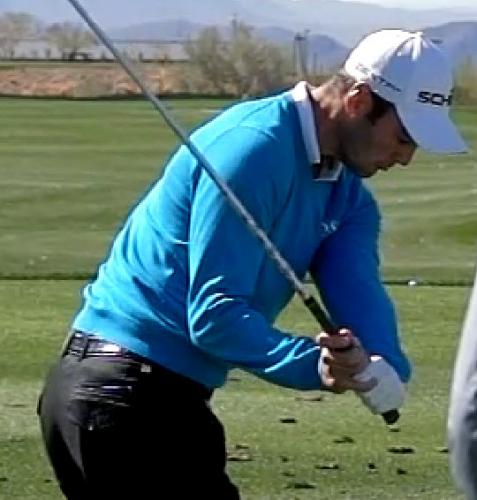
Transverse adduction of the right shoulder is also a key part of this move. This helps the right elbow get in front of the hip. If the elbow is stuck behind your hip it cannot possibly move in front unless your body stalls or stops (option #2 use Furyk method).
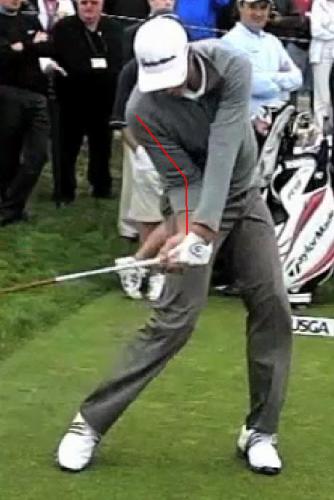
Therefore you will not be able to get to this next key position. Once you get the right elbow in front, you must drive it forward to retain external rotation for as long as is possible while rotating the thoracic spine or rib cage and adducting the right shoulder (getting the right arm in front as far as possible).
Lag Pressure Location Changes
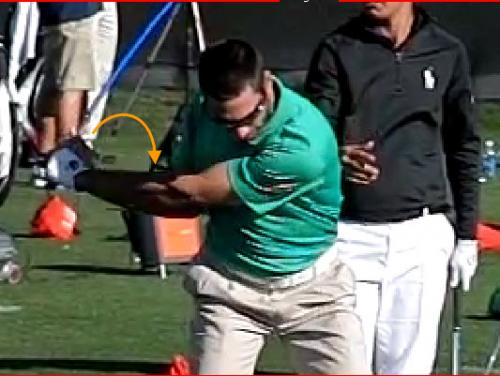
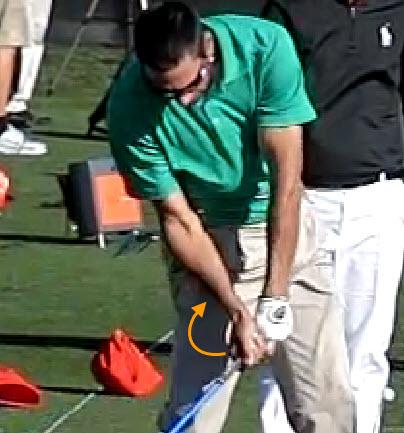
While this may seem obvious to some, it is not to everyone. Whilst at first lag is held mainly by radial deviation (left), as the club reaches horizontal, the pressure should be felt more with right wrist extension/left wrist flexion (right). Correctly performed, there also will be left forearm supination/right foream pronation. This will help with getting your clubface in the right positions which will be discussed next.
If there isn’t this pressure change, one could hold massive lag with the clubface so open that it will be impossible to get squared without some flip/roll.
Monitoring your clubface positions
Here are some checkpoints for everyone.
Top of Backswing

Very few players on the tour use a weak grip. Even rarer are tour players with an open clubface at the top of the backswing. Unless you can supinate like the great Ben Hogan, you will likely end up with some form of flip or flip/roll like Chad Campbell. Thus instead of straying into idiosyncratic moves and only a few can perform, let’s stick to what is more common to drive/holders.
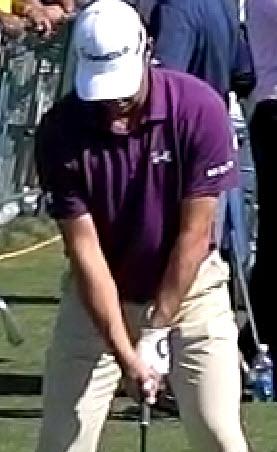
Gary Woodland has a more neutral grip and is probably on the weak end of the spectrum of what is recommended for most people.

At the top of the backswing he’s in a “perfect” square clubface position.
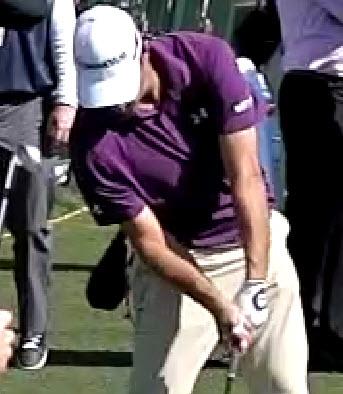
But realize that if you have a weaker grip, your position at impact most be more extreme as well.


On the other end of the extreme there guys like Dustin Johnson, David Duval, Lee Trevino, Paul Azinger, Lee Janzen, Ryan Palmer, Tommy Gainey and more who play with what Johnny Miller calls “shut to open.” It just means they are more closed with the clubface at the top therefore require less supination prior to impact in order to square the clubface.
After Transition


As I have shown before even with Hogan, the clubface begins to close early. Here’s Keegan Bradley and young Tiger with the clubface in a great position. You can see early left forearm supination in Tiger.
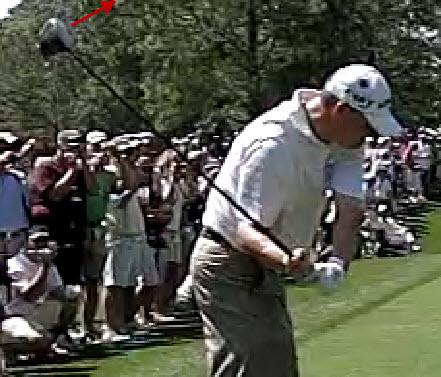
Keeping the clubface open is not recommended.
Shaft at Horizontal

Too open.
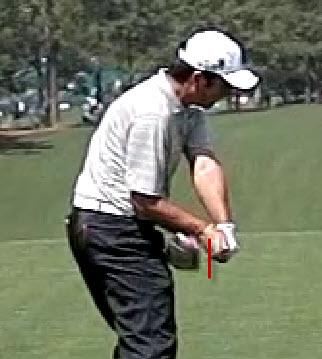
Francesco Molinari with what some would argue is ideal. Yet, this clubface position typically leads to some type of flip or underflip release.
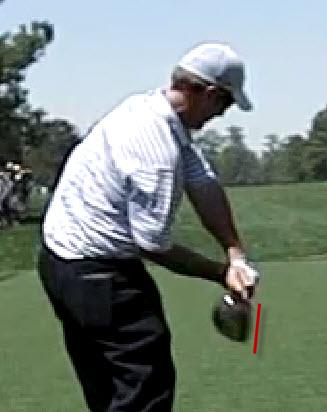

Some would say that this is going to lead to hooking. Yet Duval played a fade while Keegan plays a little draw. This is not the defining moment. A lot can still change from here till impact. This position will give you the best chance for drive/holding.
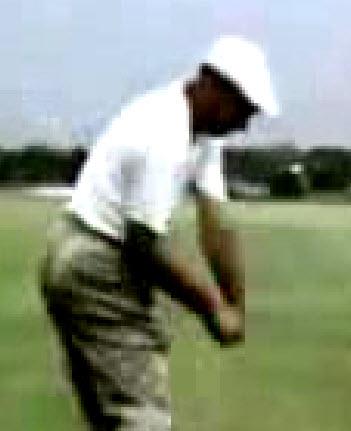

One can only guess at Hogan’s clubface position without having high shutter speeds back then. But judging from his left forearm/wrist position, you can imagine the clubface was similar to Tiger’s.
Once you have these clubface positions in place, you should start looking at clubface movements in the impact zone. With all the potentially different ways to grip the club, there’s no way to tell when you have the movements “just right” simply by looking at the movements or arm/hand positions. One must also monitor the clubface positions in order to see if the clubface is still too open or if too closed.
Ultimately if your club doesn’t look something like this in the hitting zone, you’re not going to be consistent at hitting it straight. This is a close up of JB Holmes clubface movements in the impact zone.
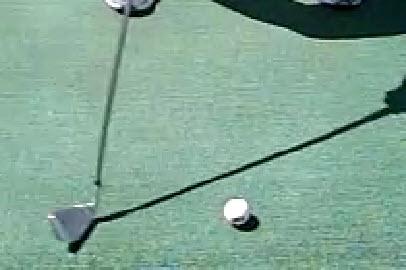
Too open! Generally speaking the higher your handicap, the greater the error potential at this point.


Goldilocks says, “Too closed!”
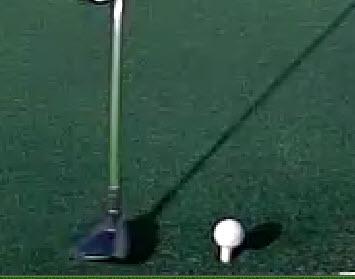
Square face but not enough shaft lean.
If you have your clubface positions in order, you are ready to tackle your impact zone movements.
Fixes
Once you know what release style you are using, you should be able to understand why it works intermittently. So here are some hints to work on improving your release style. Each release style has its own set of built in movements that need to be fixed. It is also important to realize that no release style has everything wrong! Perhaps there is a missing move or out of sequence but once you put in the correct move (or pair), improvement is automatic.
A general rule of thumb might be that if one’s spine does not produce enough rotational energy to hit the ball, another body part will take over the role (shoulders, arms, hands). Thus, flipping in all its forms is really an indication that one’s spine is not producing enough energy or stalls way before impact therefore the smaller muscles are taking over.
Also hindering progress for flippers and flip/rollers is that that they can more easily time their last millisecond adjustments when the body isn’t moving so fast. So some flippers might be unconsciously stalling (or consciously doing this due to instruction) to help them time the release better. This vicious circle helps to make golf challenging even from the white tees.
Contrast that to drive/holders that are tying their release pattern to their spine rotation. Like a gear driven watch that can run fast or slow yet the minute hand is always synced with the hour hand, the faster their spine rotates the faster their release works to keep in sync. This allows drive/holders to rip it whenever they feel the urge to while keeping the ball in play.
Underflippers predicament
Pro underflippers and high level amateur underflippers are probably happy with the way they hit it since they can be very accurate. But let’s say they wanted to move toward a swing with more power. What could they do?
Perhaps you remember the story of Ian Baker Finch who won the British Open then desired to improve his driving distance and loses his swing while on his search. The odds are not with you to do this right if you’re going to keep this release style and try to hit it longer. If you increase the speed of your body and your release isn’t tied to it that spells disaster for a swing that relies on a stall to time the underflip release. Read this tragic tale in this article from Sports Illustrated. http://sportsillustrated.cnn.com/vault/article/magazine/MAG1012082/index.htm
In order to hit it longer and keep it in play, he’d have to change release style a drive/hold method and given that the Leadbetter release is at best an underflip or flip of some variety there was little to no chance that he was ever given the right instruction to actually make this change to hit it longer/straighter.
Adam Scott’s Transformation
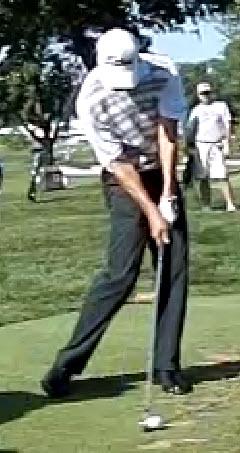
Adam Scott has always been a good iron player. But I’ve not liked his release with his driver since he tended to underflip a bit. So here’s a lesson we could all use from the newly crowned Masters Champion.
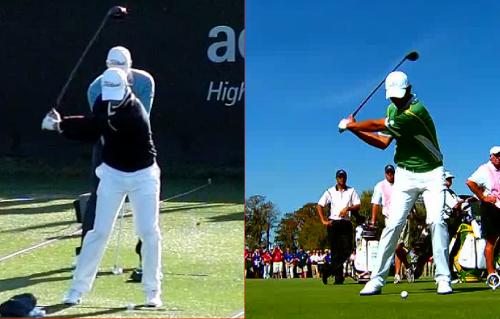
The swing on the left is from 2011 while on the right is from Tavistock Cup 2013. At this point he looks pretty similar.
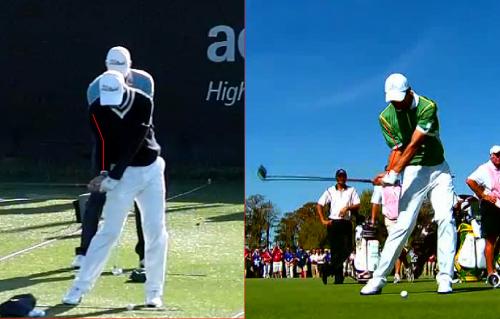
But now we can start to see the differences. On the right he has more external rotation of the right shoulder and more adduction.
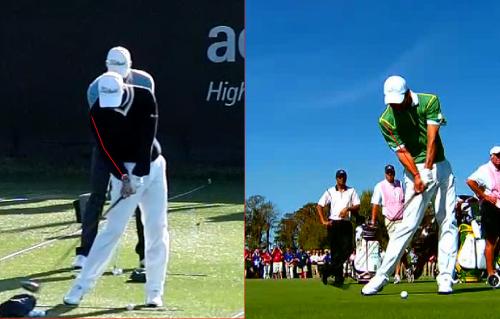
On the left, Adam has stopped adducting the right shoulder and fired internally. On the right he’s still adducting and therefore has barely started internal rotation.
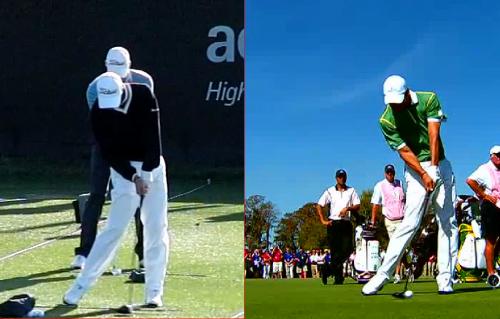
On the left it leads to underflip.
He’s also looking a bit more dynamic with his hip rotation and drive/holding now. Kudos to Adam and his coach for turning him from an underflipper into a drive/holding superstar.
Flip Release Fixes
All flip releases share some common errors.
Early right shoulder internal rotation is one of the biggest destroyers of a good release. This movement is tied to thoracic spine or rib cage rotation. Without that rotation, the external rotation of the right shoulder cannot be held and the internal rotation of the right shoulder fires off a whole chain reaction that will ensure a flip and many times a steep downswing plane.
Countering the high rate of right wrist flexion
High rate of right wrist flexion (the wrist flexion comes with a bit of right forearm supination) needs to be countered by left shoulder abduction (frontal plane), flexion (sagittal plane), internal rotation, rib cage rotation and left wrist flexion/early left forearm supination.
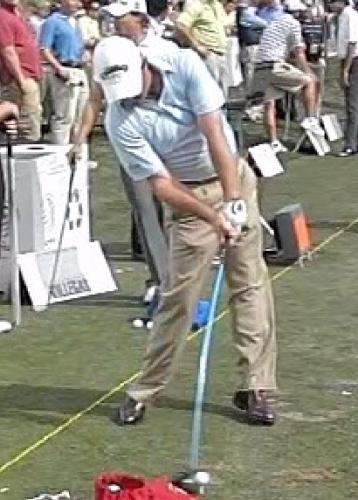
Here’s left shoulder abduction or left arm moving away from the chest. Left shoulder internal rotation is seen by the left elbow pointing at the target instead of back towards the ribs.
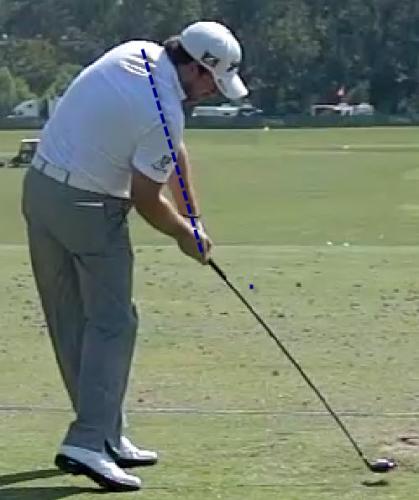
Left shoulder flexion or arm elevation is shown by GMac.
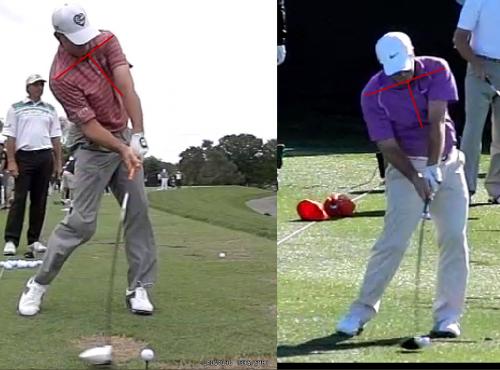
This graphic is fraught with distortion but nevertheless gives you an idea of where your sternum is aligned at impact. On the right is Francesco Molinari. An amateur flipper looks pretty square at impact with closed shoulders and square hips to target line.
Bill Haas has his left wrist in a relatively neutral position but drives his wrist into flexion through impact. This definitely has a neutralizing effect on his right wrist flexion. This takes a lot of effort and training if you’ve been flipping it for years but the fruits of your labor will be well worth it.
Tiger Stinger
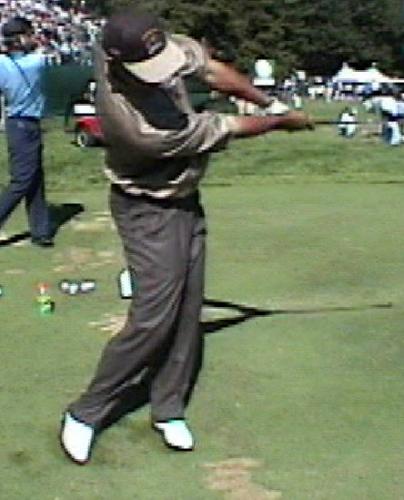
Johnny Miller mentioned this many times. Anyone that can hit a ball with this follow through really knows how to hit a ball. Can you? This requires absolute control of the clubface from the left forearm movements as well as keeping the rate of right wrist flexion very low.
Clusters of Movements
Sometimes we accept golf instruction or tips without any analysis as to whether it is in accordance to the laws of the human body. Since golf teachers don’t study anatomy, we could not expect everything said to be true. For example, how about the notion of “keeping the left arm straight”? We blindly accept this but do you know what this does to your swing anatomically?
Elbow Extension Cluster
If you straighten the left elbow (some can even hyperextend) using your triceps, this will cause a pull via the connective tissues that will automatically pronate the left forearm AND extend the left wrist! If you’ve been paying attention, I have just described a cluster of movements that make up an underflip release.
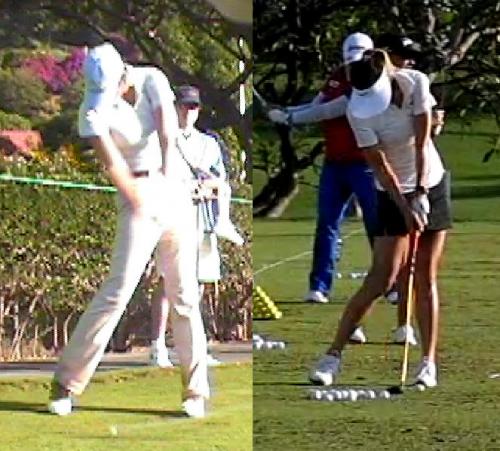
Here’s Wiesy from 2004 vs. 2013. Sorry shutter speed too low on left. But you can clearly see the bend in her left arm and now it is so straight and pretty. She had incredible body rotation on left while on the right she is the epitome of lower body stability and snapping that kinetic chain along with her underflip release.
Elbow Flexion/supination cluster
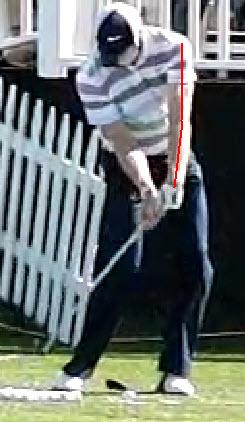
Now that I’ve told you that, you need to tap into a different cluster. Left forearm supination is performed by your left bicep which also flex the left elbow (bends it ever so slightly) which also allows for left wrist flexion (bowing). This cluster needs to be driven through impact and then trigger the elbow extension cluster post-impact. This will make drive/holding easier for you.
Special needs for Slice/Fade Flip Releasers
I’ll admit it. In my earlier years, I had no clue as to how the swing actually worked. One of the things I thought I knew was a bit of planeology. Thus a steep, over the top should be cured by a massive dose of flattening and a flip/roll hook release prescribed. Yes, probably better than the over the top slice but with my only guideline being that everyone must swing on the original shaft plane, it’s hard to imagine golfing nirvana there especially with the stuck right elbow and flip/roll hook release added.
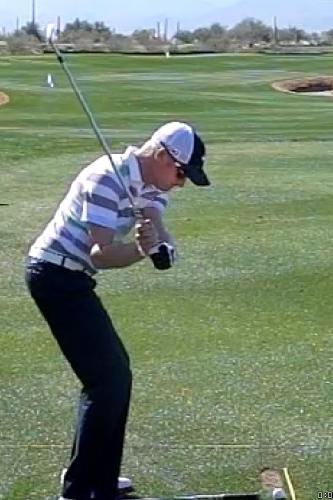
Here’s Simon Dyson with a steep downswing plane. Why can he be steep yet be in the top 64 in the world to make it to the Accenture Match Play? Could it be that his excellent release trumps or is more important than his being off plane?
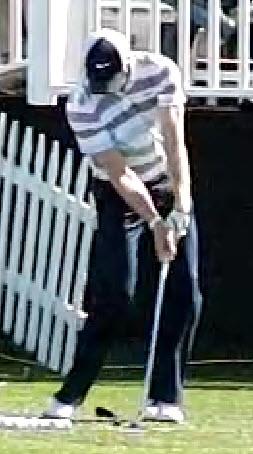
Yet he has the most bowed left wrist at impact in all of golf.
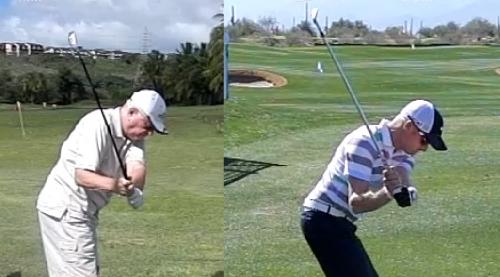
A cursory look at the plane of my over-the-top slicer student and Dyson shows little difference. So the answer is not there. Look at clubface position. What do you see? Simon’s is more closed.
What about right shoulder and elbow position? Simon is in external rotation and elbow flexion. The slicer is internally rotating and extending the elbow.
What about forearm position? Simon has his left forearm in a supinated position and right forearm in pronation. Slicer has his left forearm in pronation and right forearm in supination.
What about wrist position? Simon already has his left wrist in flexion/right wrist in extension. Slicer has opposite positions.
All this leads to what you can or cannot do with your release. From the slicer’s position, there isn’t much choice but to continue on with those positions and fire ulnar deviation (massive casting move) since that “natural.”
So this highlights the reasons for getting clubface angle under control since they are tied to anatomical movements. But there’s more work to be done for slicers.
Since the natural habit of slicers is left forearm pronation/right forearm supination, they must fight that tendency by moving toward a roller’s release. They must try to keep left wrist in flexion but roll (left forearm supination/right forearm pronation) in order to hit the ball straighter. The roller’s forearm movements will help to create an in-to-out path.
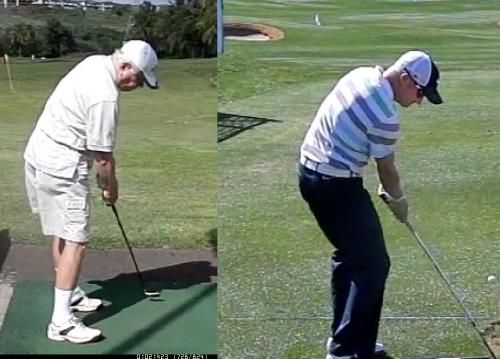
What also can change the path is sagittal plane shoulder flexion or lifting the arms away from the body from before impact. Since the slicer’s anatomical movements are causing the path to swing from out-to-in, their left shoulder is always pulling into extension (chicken winging it!).
Thus the combination of forearm and shoulder movements will get the club swinging more at the target vs. too much left.
UD and internal rotation of left shoulder
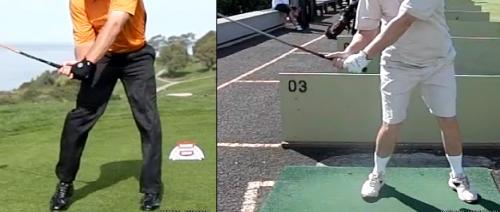
Earlier release of radial deviation or a move toward ulnar deviation might scare some people because they think it will cause them to lose lag.
Also, let us not forget the 2D distortion effects. JB might be releasing some of his lag but due to UD but since he has flattened his plane, the angle is distorted to appear like he’s holding more lag.
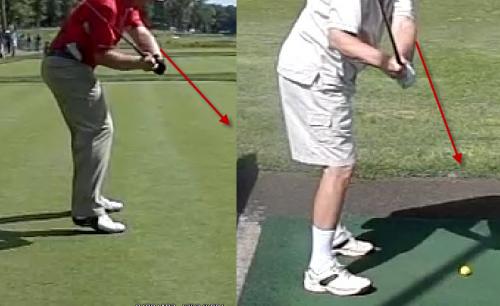
Seems JB has increased the internal rotation of his left shoulder to flatten his plane. Meanwhile the slicer has decreased the amount of left shoulder internal rotation or moved toward external rotation.
Arm Plane
And isn’t JB’s left arm farther out than the slicer’s? I thought we were supposed to drop the arms flatter to swing the club flatter?

Here’s Sergio in a slightly more inside left arm position as the slicer. But is that necessary?
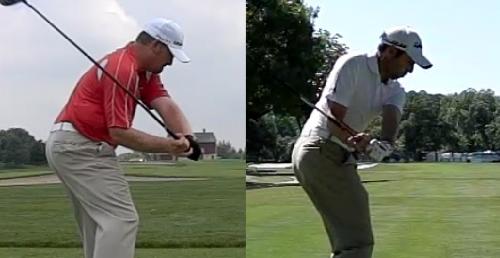
As JB shows, the arm doesn’t have to be so inside at that point.
Shoulder Flexion or Arm Elevation
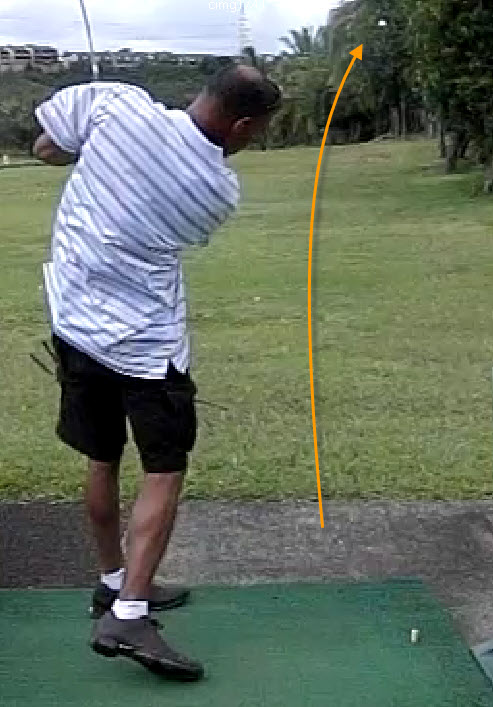
Lastly, since slicers are pulling the arms left or moving to extension on the follow through, they need to roll the forearms and add shoulder flexion (sagittal view).
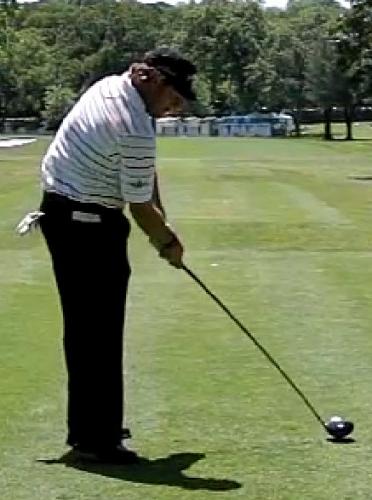
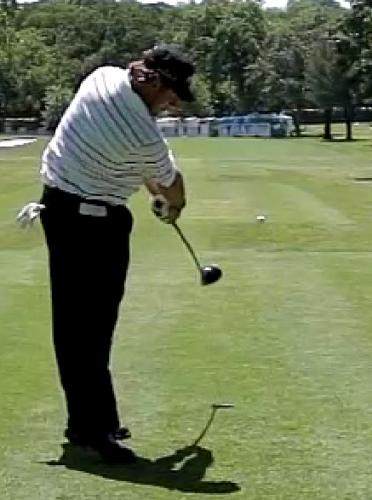
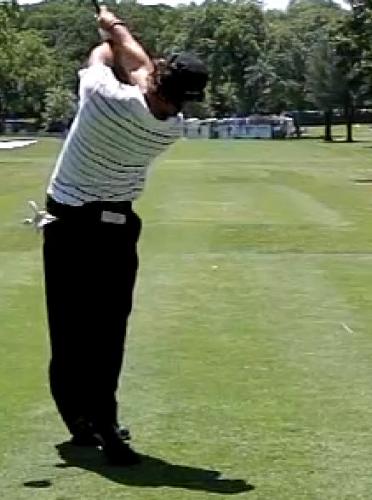
Here’s Alex Cejka showing this type of arm elevation and creating a high follow through that matches the rolling forearms.
Fixes for Flip/Roll Hookers
Rollers and Flip/Rolling Hook bias release styles share some common moves. Typically their left forearm is pronated until just before impact and this creates a need to close the clubface very fast or hit a big push fade/slice. Since they don’t want to hit that shot, they will throw everything and the kitchen sink at the problem.
Thus they use all the possible movements that can close the clubface. Left shoulder external rotation, left shoulder adduction (slows the arm down so the club can pass), left forearm supination and right forearm pronation. In addition, hookers are using radial deviation. If these players stall the body it can be even more effective (whether they want to or not) in closing the clubface.
Hold left shoulder internal rotation

Danny Lee on left holding left shoulder internal rotation while Richard S. Johnson is externally rotating the left shoulder. This will help hold off some of the clubface rotation.
Roll only one side
Next, remove the rolling from one of the forearms since hookers are rolling both forearms. This will transform the flip/roll into some type of an underflip. Perhaps this might take some experimentation to figure out which side you want to remove the roll from.
Here’s Karine Icher using strong right forearm supination and right wrist flexion to counter left wrist extension and left forearm supination. The next step for her would be to control the left wrist by keeping it in flexion vs. succumbing to the extension (cupping).
Belen Mozo uses the right forearm pronation and counters with left forearm pronation. As she shows, it also helps to straighten the left arm since it will trigger the left elbow extension cluster.
Either of these two methods should yield some reduction in hooking.
Players with extremely strong grips may need to use mirrored movements of the left forearm pronation/right forearm supination in the left frames prior to contact to stop the clubface rotation.
UD
An important part of the fix for hookers is ulnar deviation. This will help the club move under the hands and swing the clubhead left. Without ulnar deviation the wrists will tend to move to radial deviation and cause the path to shift to the right creating more hook potential.
Left arm extension (sagittal plane)
The more the left arm is working away from the ball, the more it will shift the club path to the left.
Hopefully this last in this series of articles on the release sheds some light on the difficulty everyone has with the unmasterable golf swing. Looking at the similarities in flaws and roots of the problems yields an even simpler set of movements that typically need some attention.
The Impact Snap device is back in stock after a long wait.

